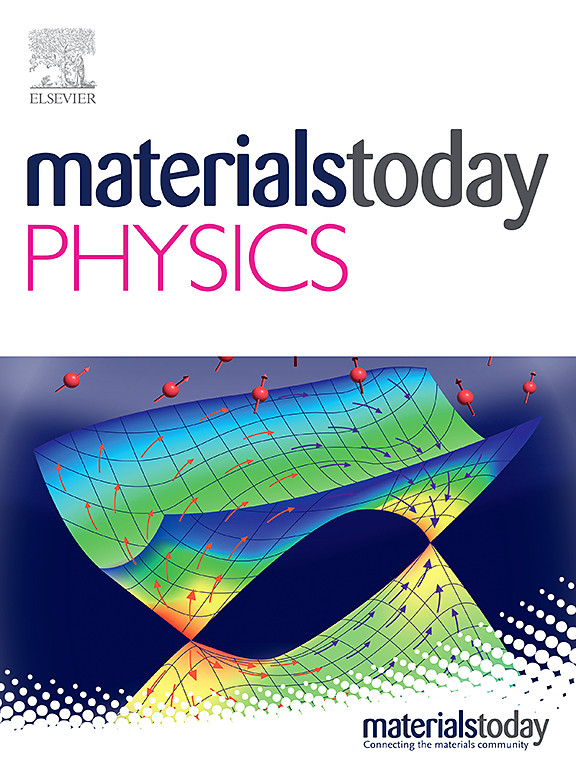Effect of magnetic entropy in the thermoelectric properties of Fe-doped Fe2VAl full-Heusler alloy
IF 10
2区 材料科学
Q1 MATERIALS SCIENCE, MULTIDISCIPLINARY
引用次数: 0
Abstract
The effect of spin entropy on the transport of heat/charge carriers in the Fe-doped full-Heusler alloy Fe2+xVAl1-x with x = 0–0.1 has been studied through low-temperature magnetic and thermoelectric measurements. Magnetization (M) measurements confirm itinerant-electron weak-ferromagnetic behavior. A systematic increase of the magnetic transition temperature TC (from 40 K to 223 K) and of the saturation magnetization (from 0.13 to 0.41μB/Fe) with increasing Fe doping (from x = 0 to 0.1) is observed. Applying a magnetic field causes significant suppression of the Seebeck coefficient (S) and the entropy term (S/T) with a negative magnetoresistance near TC for all weak-ferromagnetic samples, demonstrating a clear effect of spin fluctuations. Analyzing M(T) and S(T), we rule out sizeable magnon drag contributions. A large spin fluctuations-induced enhancement in the thermoelectric power factor PF of about 18 % is achieved for x = 0.1 near TC when compared to measurements in a magnetic field of 7 T. The actual improvement in PF is even much higher, as the S shows a significant enhancement (about 34 %) compared to the estimated diffusion term of S(T) at TC. The number of point defects also increases with Fe doping, causing a significant reduction of the lattice thermal conductivity. This study demonstrates the role of spin fluctuations in enhancing the thermopower/thermoelectric performance of Fe-doped Fe2VAl and opens a vista for the strategy's applicability for various thermoelectric materials.
磁熵对掺铁的 Fe2VAl 全赫斯勒合金热电性能的影响
通过低温磁性和热电测量,研究了自旋熵对 x = 0 - 0.1 的掺铁全赫斯勒合金 Fe2+xVAl1-x 中热/电荷载流子传输的影响。磁化(M)测量证实了巡回电子弱铁磁行为。随着铁掺杂量的增加(从 x = 0 到 0.1),磁转变温度 TC(从 40 K 到 223 K)和饱和磁化率(从 0.13 到 0.41μB/Fe)出现了系统性增长。对于所有弱铁磁性样品,施加磁场会显著抑制塞贝克系数(S)和熵项(S/T),并在 TC 附近产生负磁阻,这表明自旋波动具有明显的影响。通过分析 M(T) 和 S(T),我们排除了可观的磁子阻力贡献。与 7 T 磁场中的测量结果相比,x = 0.1 时 TC 附近的热电功率因数 PF 在自旋波动的诱导下大幅提高了约 18%。由于 S 在 TC 时比估计的 S(T) 扩散项有显著提高(约 34%),PF 的实际提高幅度甚至更大。点缺陷的数量也随着铁的掺杂而增加,导致晶格热导率显著降低。这项研究证明了自旋波动在提高掺铁 Fe2VAl 的热功率/热电性能中的作用,并为该策略在各种热电材料中的应用开辟了前景。
本文章由计算机程序翻译,如有差异,请以英文原文为准。
求助全文
约1分钟内获得全文
求助全文
来源期刊

Materials Today Physics
Materials Science-General Materials Science
CiteScore
14.00
自引率
7.80%
发文量
284
审稿时长
15 days
期刊介绍:
Materials Today Physics is a multi-disciplinary journal focused on the physics of materials, encompassing both the physical properties and materials synthesis. Operating at the interface of physics and materials science, this journal covers one of the largest and most dynamic fields within physical science. The forefront research in materials physics is driving advancements in new materials, uncovering new physics, and fostering novel applications at an unprecedented pace.
 求助内容:
求助内容: 应助结果提醒方式:
应助结果提醒方式:


